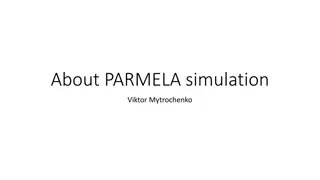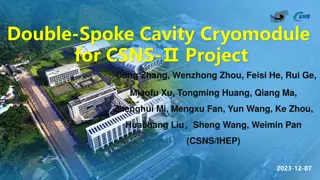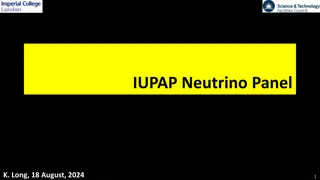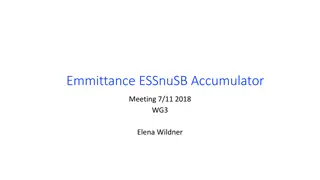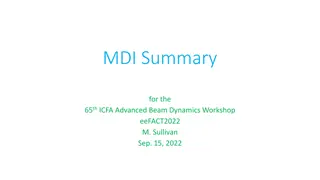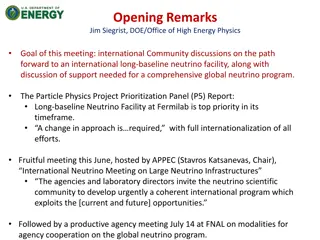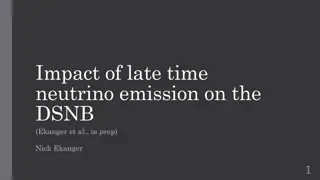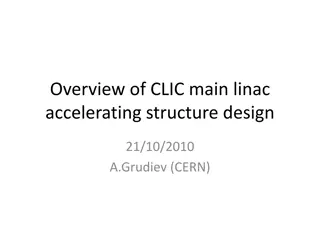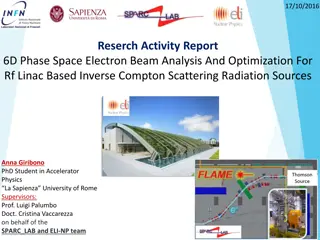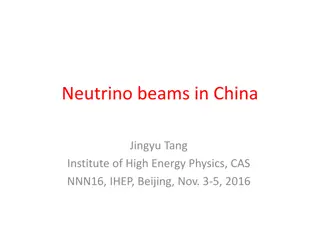ESSnuSB Project - Linac Upgrade for Neutrino Beam Generation
Explore the ESSnuSB project's linac upgrade featuring beam pulsing schemes and modifications, aiming to provide an additional 5 MW of beam power for neutrino generation. The upgrade options, pulse structure, beam parameters at 2.5 GeV, and different pulsing schemes are detailed with images and descriptions from the collaboration meeting. The discussion includes considerations for current, particle count, pulse length, and frequency in enhancing beam delivery efficiency.
Download Presentation

Please find below an Image/Link to download the presentation.
The content on the website is provided AS IS for your information and personal use only. It may not be sold, licensed, or shared on other websites without obtaining consent from the author. Download presentation by click this link. If you encounter any issues during the download, it is possible that the publisher has removed the file from their server.
E N D
Presentation Transcript
ESS Linac H beam pulsing schemes for ESSnuSB project Bj rn G lnander, ESS ESSnuSB collaboration meeting Strasbourg 5-9 November 2018-11-07 1
Linac modification Mamad Eshraqi 2018-11-07 B. G lnander, ESSnuSB, Strasbourg 2
ESSnuSB upgrade options The ESSnuSB requires the ESS linac to provide an additional 5 MW of beam power for neutrino generation. Any energy upgrade beyond 2 GeV will simplify the delivery of a second 5 MW beam from the ESS linac, lower current. With the energy upgrade to 2.5 GeV the increase of average power needed from the nominal Radio Frequency (RF) stations is ~80 %, which looks feasible within the existing RF gallery space. The high-beta superconducting cavities have a total filling time of around 0.3 ms, and for a beam duty cycle of 8%: 28 Hz yields an RF duty cycle of 8.4% 56 Hz yields an RF duty cycle of 9.45 2018-11-07 B. G lnander, ESSnuSB, Strasbourg 3
Pulsing schemes A, B Baseline 8 % duty cycle C Not compatible with present RF modulator design. Feasible with new, separate modulator system. D 2018-11-07 B. G lnander, ESSnuSB, Strasbourg 4
Pulse structure baseline, A and B Scenario A, max pulse length 2.9 ms limited by RF modulators -> increase current to 55 mA @ 2.5 GeV 2.9 ms 36 ms (1/28 Hz) 2.86 ms 8.25 1014 particles per macro pulse 28 Hz (RF) p+ H- 650 s 100 s Four subpulses with injection gap 100 s. (extraction kicker fall time) 2.1 1014 particles per subpulse 100 ns 1.23 s Chopped subpulse with extraction gap 100 ns (extraction kicker rise time) 489 pulses with 4.2 1011 particles. Micro bunches, 2.84 ns (352 MHz) 2018-11-07 5 B. G lnander, ESSnuSB, Strasbourg
Beam parameters @ 2.5 GeV for different schemes Scenario A, B C D Current 55 mA ~32 mA 50 mA 2.1 1014 2.75 1014 2.75 1014 Particles per subpulse Pulse length (ms) 0.65 ~1.5 * 0.95 Frequency 14 Hz (1.3 kHz) 56 Hz 56 Hz Number of subpulses per macro period 4 3 3 8.25 1014 8.25 1014 8.25 1014 Number of particles per macro period (72 ms / 14 Hz) * Time limited by storage time in accumulator ring about 1000 turns, e-p instabilities 2018-11-07 B. G lnander, ESSnuSB, Strasbourg 6
Different pulsing schemes -28 Hz pulsing of Linac with ~2.9 ms long pulses. (H-at 14 Hz). Flat top RF modulators 3.35 ms, fill time 0.3 ms, RF regulation 0.1 ms. Baseline -1 accumulator ring. -Laser stripping (has to be developed, SNS). -Every macro pulse is divided into 3 or 4 subpulses with gaps of 100us between, for extraction kickers to fall back. -Foil stripping not feasible due to heat load of foil. (moving foil is technically demanding). -Upgrade of charging capacity of modulators required. -Frequency at target too high? A. B. -28 Hz pulsing of Linac with ~ 3 ms long pulses. -3 or 4 accumulator rings. -Foil stripping. (or laser stripping) -Every macro pulse is divided into 3 or 4 subpulses with gaps of <~100 us (experience from Linac4-PSB about >~1-10 us https://cds.cern.ch/record/1326339/files/project-note-0028.pdf for switching between rings.) C. 56 Hz pulsing of ~1.5 ms long pulses. 1 accumulator ring. -Requires a major upgrade of modulators for RF system, separate modulators for H pulses. -Instability problems in the accumulator ring may develop which limits the time. -Lower beam duty cycle compared to A and B, cavity fill time ~0.3 ms. A. 56 Hz pulses, of about 0.9 ms each. 1 accumulator ring. -Requires a major upgrade of modulators for RF system, separate modulators for H pulses. -Lower beam duty cycle compared to A and B, cavity fill time ~0.3 ms. 2018-11-07 B. G lnander, ESSnuSB, Strasbourg 7
Different schemes contd Laser stripping is being developed at SNS. See presentation Ye Zou, NuFACT 18 for different injection schemes According to simulations by S. Mashida, creation of the extraction gap in the accumulator ring is not feasible, since the time to reach this is about 2 ms or 2000 turns, and instabilities will develop in this time. SNS experience e-p instabilities. See presentation Ye Zou, NuFACT 18. The chopping of the pulses for the extraction gap of around 100 ns, (100-150 ns) will be made in the MEBT (needs to be modified). This chopping will generate HOMs which can perturb the beam, and/or cause extra heat load. Simulations from Aaron Farricker, CERN. See presentation M. Eshraqi, this meeting. (SNS has a lower current, and HOM couplers but they have been removing them due to other problems). Needs further studies. Stripping due to intra-beam scattering is probably the largest problem for the linac for a current of >~ 50 mA. Preferable from this point of view to have lower current and long pulses to reduce stripping of H- , scenario C. (RF modulators need to be modified.) Needs further studies. Pulsing scheme A and B can be problematic from target point of view? Higher than 56 Hz. 2018-11-07 B. G lnander, ESSnuSB, Strasbourg 8
ESSnuSB upgrade options The identified major modifications for the doubling of the beam power via a higher repetition rate and higher beam energy are (in no particular order): Three new electrical substations along the RF gallery. A third main electrical station, alongside the 2 existing ones. HV cable trenches and pulling of additional HV cables from the main station towards the new substations. New HV cables between the substations and the modulators in the RF gallery. Installation of 8 new cryo modules and associated RF stations. Change of klystron collectors, so that 60% more average power can be produced. If klystrons are at the end of their lifetime, they could be exchanged against more powerful models. Installation of additional capacitor chargers to allow faster pulsing of the modulators. This is only possible if the modular design developed in-house is adopted. Installation of a H- source + RFQ + MEBT + beam funnel alongside the existing protons source. Exchange trim magnets and associated power supplies against pulsed versions The reviewers, Frank and Eric, did not find any show stoppers for the addition of 5 MW H- acceleration capability in the current state of the ESS linac. Extracted from the assessment report by Frank Gerigk and Eric Montesinos, CERN-ACC-NOTE-2016-0050 2018-11-07 B. G lnander, ESSnuSB, Strasbourg 9
Pulse structure old 50 mA (2.5 GeV) 3.16 ms 36 ms (1/28 Hz) 2.86 ms 8.25 1014 particles per macro pulse 28 Hz (RF) p+ H- 715 s 100 s Four subpulses with injection gap 100 s. (extraction kicker fall time) 2.1 1014 particles per subpulse 100 ns 1.23 s Chopped subpulse with extraction gap 100 ns (extraction kicker rise time) 538 pulses with 3.8 1011 particles. 2018-08-14 10 B. G lnander, NuFACT 2018


